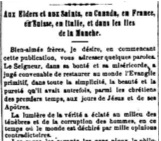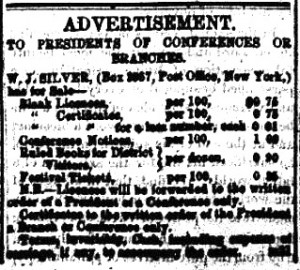Both New York City and the Church have attracted their share of unusual characters, so when we look at the Church in New York City, the characters can act quite strange. Add to that attention from sometimes equally unusual anti-Mormons and the situation will appear in the newspaper. One such case arose in the early 1840s, when a tailor and actor named George J. Adams joined the Church.
Adams quickly became a significant part of the missionary efforts in the area, preaching regularly and traveling throughout the area. In the newspaper accounts of the time, it often seems like the newspapers thought that Adams was the main representative of the Church in New York City, because he is most often mentioned in coverage.
Aligned against Adams and the Church in New York City was an evangelical minister named George Montgomery West. Born in Ireland, West emigrated to New Brunswick where he was associated with the Methodists, who labeled him an intemperate and a fraud. He went on to Ohio, becoming an Episcopalian minister there, but ran afoul of them also. By 1842 he was in New York City, where he agreed to debate George J. Adams.
Their debates were the subject of newspaper reports from late June through the end of July as the debates shifted from Boston to New York City and then to Philadelphia. Each night they would entertain audiences who paid 12 cents each to hear Adams and West argue about the claims of the LDS Church for two hours. Each debater would speak for 20 minutes, and the two would alternate to fill up the time. The New York Herald report of the debate even reached the Times and Seasons newspaper in Nauvoo, which included one of the Herald articles word for word.
In Philadelphia the collusion of the two debaters in making their debate dramatic was on full display according to the Journal of Commerce, which reported:
At the latter part of his discourse he called out with Stentorian lungs, “where now is the celebrated and learned Dr. West? He knew I was coming to Philadelphia. Why does he not appear and vindicate Orthodoxy if in his power?” At this moment a portly figure started up and electrified the audience by stating, “Ladies and gentlemen, the person who has addressed you professes to speak by inspiration, but had he possessed what he professes, he would have known that Dr. WEST IS PRESENT, and now challenges him to prove the TRUTH of his monstrosities before this enlightened community.”
Whether these histrionic debates led to any additional conversions to the Church is anyone’s guess—history is silent on the matter. However, we do know something of what happened to Adams and West in the following years.
Following the Martyrdom, Adams, still in New York City, at first defended the Twelve’s leadership of the Church against the claims of Sidney Rigdon and his followers, but eventually followed James J. Strang, becoming a leader in his church. After Strang’s death, Adams returned to New York City and the stage before founding his own church. Convinced that the Jews would soon return to Palestine, he led his flock there and established a colony near Jaffa. When that failed, some of his followers returned to the U.S., by chance on the same ship as Mark Twain, who wrote about them in his book Innocents Abroad. Adams returned to the U.S. in 1870 and died soon after.
West fared little better. He joined a Presbyterian church in Brooklyn, but was convicted by them of falsehood and drunkenness. Still fighting the LDS Church, he joined the apostate John C. Bennett for a series of lectures. By 1850 he had joined a Presbyterian church in Albany, but his bad behavior ran afoul of that group as well, leading to the publication of a pamphlet titled “Impostures and calumnies of George Montgomery West,” (1850), and his grandiosely titled response, “The Living Martyr and the Unholy Alliance; Or Calumny Exposed, Truth Defended, and Character Vindicated, by Irrefutable Evidence.”
All this reminds me of the pithy saying my mother often cited:
People’s names and people’s faces
Don’t belong in public places.
There’s often a role for attracting attention, but too often the reason someone is attracting attention is for themselves, and not for the ideals they are teaching. That is, I think, true outside and inside the Church.
Like this:
Like Loading...

